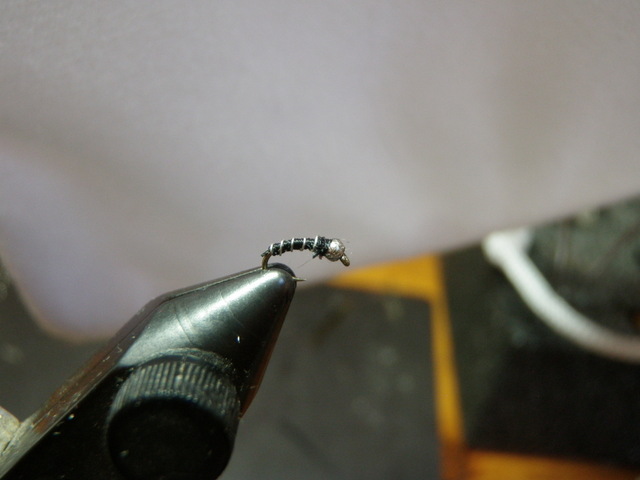Zebra Midge 01/24/2014 Photo Album
Perhaps one of the easiest flies to tie is the zebra midge. I had 13 of these small flies in stock so I decided to tie an additional 7. I completed this project in less than half an hour as the most time consuming part of the process is centering the tiny bead over the point of a size 20 hook and sliding it around the bend to the hook eye without dropping the bead or the hook on the floor. Because these hooks and beads are so tiny I clamp the hook in my vice in a backwards J position and use my tweezers to grab the bead and position it over the point of the hook. I always try to hold my hand beneath the hook in case I miss because if one of these falls to the carpet, it is goodbye bead.
Once the bead is on the hook, I simply attach my black thread to the hook and then attach a length of fine silver wire. I wrap the thread up the hook shank making sure that the metal is covered and at the same time creating a gradual taper. Once I’ve covered the hook shank, I wrap the fine silver wire forward to form a rib and then tie it off just behind the bead. The final step is to whip finish behind the bead and this creates a bit of bulk that imitates the head.
The zebra midge is a fly I should probably fish with more frequently. I fall into the trap of thinking that the fish cannot see such a tiny morsel drifting in the current; however, I must say that on the occasions when I’ve used one, I’ve had a fairly high success rate. Generally I’ve used a zebra midge in the morning before I observe larger insect activity, and it has produced fish. I can remember instances on the Frying Pan River, Big Thompson River and Arkansas River where I’ve added a zebra midge to my line and experienced some success. I’ve added it as the point fly on a two fly nymphing setup with a strike indicator, but more success has resulted from using it as the second fly below a buoyant attractor with a larger nymph above it.
I seldom fish lakes, but I’ve also had good luck with a zebra midge dangled off a Chernobyl ant or similar large attractor when I’ve noticed adult midges fluttering above the water. Hopefully I’ll recognize midge situations during 2014, and the zebra midge will serve me well.

